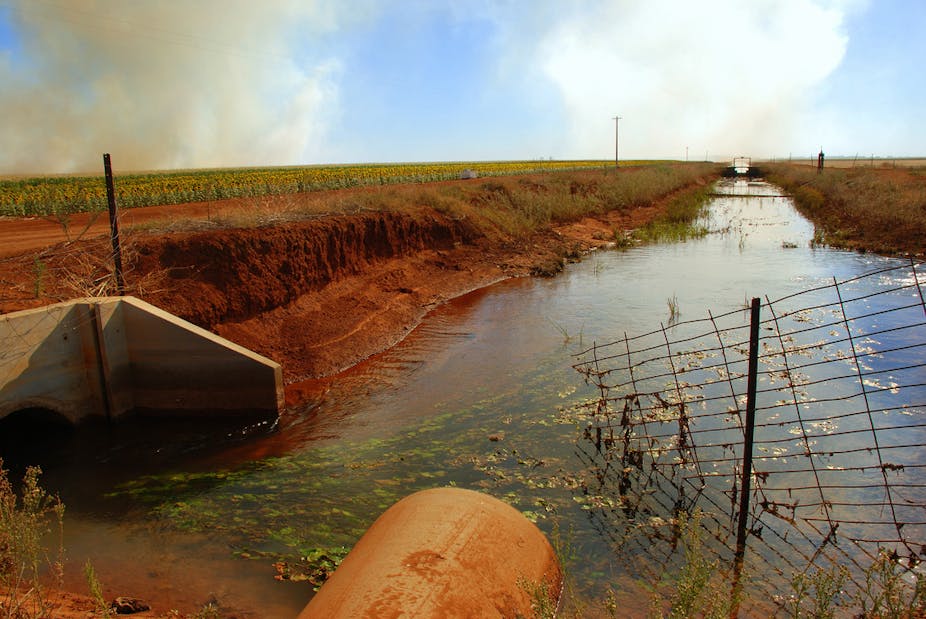Welcome to the State of the Future series. This series addresses 15 global challenges posed by the Millennium Project, an international non-profit think-tank collecting responses for 40 nodes worldwide.
The Australian node is hosted by the Institute for Sustainable Futures at the University of Technology, Sydney. UTS and the Conversation have assembled 15 articles by leading academics, each giving an Australian perspective. Together, they provide a fascinating snapshot of Australia grappling with a shifting future.
Global Challenge 2: How can everyone have sufficient clean water without conflict?
There can be no better metaphor for the manner in which natural cycles have been changed through industrialisation than the state of the world’s waterways.
Water resources are a renewable resource, or they can be. However, all over the world groundwater sources that have developed over thousands of years are being mined to depletion in mere decades, and surface water resources stretched beyond their limits.
Extraction for agriculture, hydroelectricity, and urban use has left many waterways diminished or in some cases they have been lost forever. Given the transboundary nature of many river systems, water is likely to become a major source of conflict in the future.
What is to be done?
To address this, let’s focus on three dimensions of the issue.
Firstly, as cities, irrigators, and governments have developed water resources, they have predominantly pursued a supply-side path.
The emphasis has been on developing water supplies to meet increasing demand. In both the developed and developing world, the focus has been on new dams, large-scale inter-catchment transfers, and desalination. For poorer countries this has resulted in an increased cost of water and limited access. In wealthy states, this has pushed up the price, and led to a greater level of energy use for water supply.
A demand-side approach asks the question “how can the needs of the community and households be met, with the least amount of water, and at the lowest overall cost?” This means considering the uses of water in a disaggregated way, and determining how the efficiency of water use, and the reuse of water resources, can be maximised to get the most out of each drop. In the developed world, that can mean a major reduction, up to “factor ten”, in water use, while providing the same level of service. In the developing world, it can mean bypassing, or “tunneling through”, the Kuznets Curve. This refers to the possibility that developing cities (and irrigators and industry) can avoid the increases in demand per capita that developed nations, especially countries such as Australia and the United States experienced, prior to increased efficiency.
In the developed world, demand for water and water use per tonne of produced commodity is falling as improvements are made to water use. These improvements have been driven by regulation, price, improved technology and awareness. This needs to continue and accelerate. Developing countries can avoid this path through increased consumption, and with sufficient support and up front investment, can move directly to a more efficient future. To illustrate with a fundamental and ubiquitous example, toilets in Australia and the United States were, historically, universally wasteful in terms of litres per flush (12 litres and 20 litres respectively) and yet have now reduced excess (less than 6 and less than 4 litres respectively) such that, even with population growth, it is unlikely that Australian toilets will ever flush as much water in absolute terms as they did in 2000.
Secondly, water issues are highly intertwined with other sustainability-related issues.
An example is the water-energy nexus — which works both ways. As we develop more water supply systems, the energy intensity increases, through desalination, longer inter-catchment transfers, and deeper groundwater sources. As energy use increases, conventional centralised sources use more water for cooling, or for hydropower. Thus energy efficiency can also reduce water-use. In Chile, for example, the national government is planning to develop seven large dams in Patagonia and a 2,400 km transmission line to meet a projected tripling of electricity demand by 2025. Opponents claim that improved energy efficiency, geothermal resources, and abundant solar thermal potential near the high demand copper mines in the Atacama Desert provide a ready and more suitable alternative.
Similarly, global changes in diet have put additional pressure on water, and many other resources. Dramatic increases in food sourced from animal products (meat and dairy) have increased water demand, often used for cereals fed to livestock. Currently, livestock for human consumption contributes to one quarter of all water use. Eating further down the food chain will significantly reduce water use, along with reductions in greenhouse gas emissions and nutrient use.
Thirdly, the governance of water is important. Communities should have the right to manage the water resources in their region, within the limits of the resource and the environment, and for the benefit of those communities. This requires robust methods of community engagement, with citizens, and their preferences and values being recognised, and being informed by data on the resource and its constraints. Much of the supply-side thinking has been driven by governments or companies out of touch with the actual needs or preferences of citizens. From the unnecessary desalination plant in Sydney, Australia to protests over privatised water resources in Cochobamba, Bolivia, there is a common thread of poor decision making, inappropriate exertion of power, and lack of community engagement.
Addressing these three challenges alone will not solve global water issues. Concerted action is needed at all levels of government. Technical advances will help, but by and large institutional barriers remain the largest obstacle. Political will, community awareness and action and strong informed processes of community engagement and decision-making processes that take account of the demand side represent the best hope for the future of water.
Comments welcome below.

